
A raceme or racemoid is an unbranched, indeterminate type of inflorescence bearing pedicellate flowers along its axis. In botany, an axis means a shoot, in this case one bearing the flowers. In indeterminate inflorescence-like racemes, the oldest flowers are borne towards the base and new flowers are produced as the shoot grows, with no predetermined growth limit. A plant that flowers on a showy raceme may have this reflected in its scientific name, e.g. Cimicifuga racemosa. A compound raceme, also called a panicle, has a branching main axis. Examples of racemes occur on mustard and radish plants.

Arisaema is a large and diverse genus of the flowering plant family Araceae. The largest concentration of species is in China and Japan, with other species native to other parts of southern Asia as well as eastern and central Africa, Mexico and eastern North America. Asiatic species are often called cobra lilies, while western species are often called jack-in-the-pulpit; both names refer to the distinctive appearance of the flower, which consists of an erect central spadix rising from a spathe.

Arisaema triphyllum is a herbaceous perennial plant growing from a corm. It is a highly variable species typically growing 30–65 centimetres (12–26 in) in height with three-parted leaves and flowers contained in a spadix that is covered by a hood. It is native to eastern North America, occurring in moist woodlands and thickets from Nova Scotia west to Minnesota, and south to southern Florida and Texas.

Arisaema sikokianum, the Japanese Jack-in-the-pulpit, is a herbaceous perennial plant. An unusual woodland plant noted for its unmistakable smoky-purple base, snow-white cup and large hood with purple, green and white stripes. Found only in moist, shaded areas on the Island of Shikoku in Japan. It is closely related to Arisaema triphyllum, which is common to the eastern United States. In home gardens, it is a springtime planting and is often placed with shade-loving hostas and bleeding hearts.
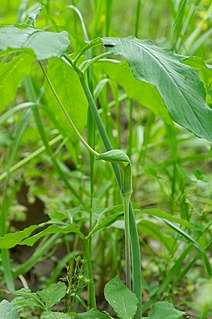
Arisaema dracontium, the dragon-root or green dragon, is a herbaceous perennial plant in the genus Arisaema and the family Araceae. It is native to North America from Quebec through Minnesota south through Florida and Texas, where it is found growing in damp woods. It has also been reported from northeastern Mexico Plants grow 20–50 centimetres (7.9–19.7 in) tall when in bloom and after flowering reach 100 centimetres (39 in), and each grows from a corm. Normally, a plant produces one leaf with a long petioles, its leaf is composed of 7 to 13 leaflets, with its central leaflet being the largest one and with leaflets becoming smaller as they are produced distally, the leaflets are held out horizontally over the plant. During flowering in spring, a single slender, green spathe 3–6 centimetres (1.2–2.4 in) long is produced; it covers a tapering, long thin spadix. The tail-like spadix grows out around the top of its spathe. After flowering, up to 150 berries are produced in a club-shaped column. In late summer, the green berries turn orange-red, each berry produces 1 to 3 seeds. It is listed as a vulnerable species in Canada.
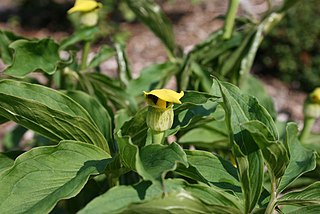
Arisaema flavum is a species of flowering plant widespread across north-eastern Africa and southern Asia. It is native to Ethiopia, Somalia, the Arabian Peninsula, Pakistan, Afghanistan, Nepal, Assam, Himalayas, Tibet, Yunnan, and Sichuan. The species epithet flavum is Latin for yellow and indicates its flower colour.

Arisaema thunbergii subsp. urashima is a herbaceous perennial plant. It is widespread through the woodlands of Japan, especially near the coast. The plant has a very curious inflorescence, and is popular in horticulture. As with all arisaemas, the inflorescence consists of a spathe tube enclosing a spadix appendix. In the case of A. thunbergi subsp. urashima, the spadix appendix is elongated into a free hanging thread of 45 to 60 cm. The underground tuber often produces offsets, which can be removed and grown on. The foliage dies down by summer, leaving the fruiting spike to ripen in autumn. The red berries contain high amounts of oxalic acid, and can cause painful irritation to the skin. All parts of the plant should be considered poisonous.
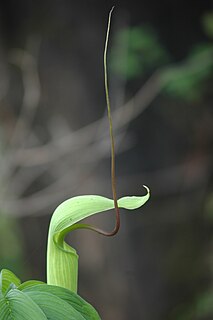
Arisaema tortuosum, the whipcord cobra lily, is a plant species in the family Araceae. It has a distinctive purple or green whip-like spadix which arises from the mouth of its "jack-in the-pulpit" flower and may be up to 30 cm long. Flowers may be male or bisexual. The clustered fruits are green at first, ripening to red. The plant grows in large clumps and can be up to 2 metres in height.
Hiroyoshi Ohashi is a botanist formerly at the University of Tokyo and Tohoku University. He began publishing on Japanese Arisaema in the early 1960s. He published a couple of miscellaneous notes on Arisaema in 1963 and 1964 and these were followed by a revision of the genus for Japan jointly published in 1980 with J. Murata, and by the Araceae treatment for the Wildflowers of Japan.
Blue Heron Park is a nature refuge on the South Shore of Staten Island, New York. It has various natural areas including meadows, kettle ponds, freshwater streams and marshes, and woodlands. The park, maintained by the New York City Department of Parks and Recreation, was acquired by the city in several parcels between 1974 and 2001, with the official dedication taking place on October 22, 1996.

Arisaema candidissimum is a species of flowering plant in the arum family (Araceae), originating in western China. Various English names have been given to the species, including Chinese cobra lily and Chinese jack-in-the-pulpit. The Chinese name is 白苞南星.
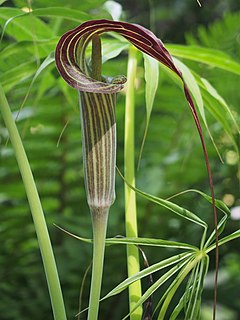
Arisaema erubescens is a flowering plant species in the genus Arisaema, endemic to Nepal.
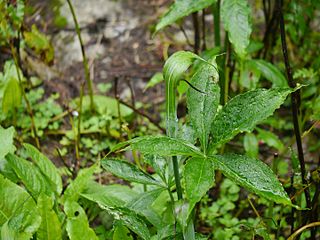
Arisaema jacquemontii is a species of flowering plant from the family Araceae that can be found growing on rocky slopes and in the forests on the elevation of 2,400–4,000 metres (7,900–13,100 ft) in 'Afghanistan, East Asia and Himalayas. The species name refers to French botanist Victor Jacquemont.
Arisaema quinatum, the Indian turnip or jack-in-the-pulpit, is a plant species in the Araceae. It is native to the southeastern United States from Texas and Florida north to Kentucky and North Carolina.

Arisaema ciliatum is a plant species in the family Araceae. It is found in Lijang, Yunnan, China at elevations of 2500 meters.

Arisaema thunbergii, commonly known as Asian jack-in-the-pulpit, is a plant species in the family Araceae. It is found in Japan at elevations of 20–100 meters.

Arisaema yamatense is a plant species in the family Araceae. It is found in Japan.

Arisaema serratum is a species of flowering plant in the arum family (Araceae). It is native Japan, where it is found from the Kansai region north to the island of Hokkaido. Its natural habitat is damp forests.

Diphasic sex expression, is defined as the alteration of the primary sex during the lifetime of an individual found within dioecious and subdioecious species of plants. This change in sex expression is a response to environmental cues such as sun exposure and rainfall or drought levels. Labile sex expression is a type of diphasic sex expression that is found among many perennial plant species, and is defined as the switch from male to female once the plant has reached a certain size. In species with labile sex expression this change occurs only once, where as a plant expressing diphasic sex tendencies can switch from season to season.

Arisaema speciosum is a species of flowering plant in the family Araceae, native to Nepal, East Himalaya, Assam, Tibet and south-central China.

















